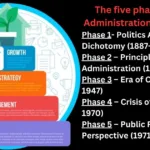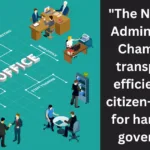Welcome to this comprehensive article that will delve into the critical topic of administrative reforms in India. Specifically, we will focus on the significant reforms undertaken in 1966 and 2005, which have played a vital role in shaping the administrative landscape of India.
Administrative reforms are critical for any country to ensure effective governance, improved public service delivery, and efficient functioning of the government machinery. India, a country with a vast and complex administrative system, has faced several challenges in managing its bureaucracy.
In 1966, the Indian government initiated significant administrative reforms to address the issues faced by the administrative system. Similarly, in 2005, the government introduced a series of reforms to further enhance the efficiency and effectiveness of the system. Understanding the history, objectives, and impact of these reforms is crucial to assess the current state of India’s administrative system and identify the future prospects for reform initiatives.
Key Takeaways:
- Administrative reforms are vital for effective governance in any country
- India has faced several challenges in managing its complex administrative system
- In 1966 and 2005, India introduced significant administrative reforms to address the issues faced by the system
- Assessing the history, objectives, and impact of these reforms is crucial to identify future prospects for reform initiatives
- The future prospects for administrative reforms in India are critical for building a robust administrative system
Understanding the Need for Administrative Reforms
India has long recognized the need for administrative reforms to address the challenges in its governance system. These challenges have been numerous and complex, ranging from corruption and bureaucratic inefficiencies to inadequate infrastructure and limited access to public services. The administrative machinery has struggled to keep pace with the demands of a rapidly changing society, leading to a growing sense of frustration and dissatisfaction among citizens.
The challenges in administrative reforms are multi-dimensional and require a comprehensive approach. One of the primary obstacles is the entrenched bureaucracy that is resistant to change and often lacks the necessary skills and expertise to deliver results. The lack of coordination and communication between different levels of government has also hindered effective policy implementation. Furthermore, political interference and influence have often impeded the impartial functioning of administrative institutions.
Administrative reforms in India face significant challenges, but they are essential for building a responsive and accountable government that can meet the needs of its citizens. Without effective reform initiatives, India’s development goals will remain elusive, and the trust of its people in the government will continue to erode.
“Administrative reforms in India face significant challenges, but they are essential for building a responsive and accountable government that can meet the needs of its citizens.”
The 1966 Administrative Reforms in India
The year 1966 marked a significant turning point in the history of administrative reforms in India. The government, led by then-Prime Minister Indira Gandhi, initiated a series of reforms aimed at streamlining the administrative machinery and improving governance.
The reforms were primarily driven by the need to address the challenges facing the administrative system at the time, such as bureaucratic inefficiencies, corruption, and lack of accountability. The overarching goal of the reforms was to establish a more efficient, responsive, and citizen-centric administrative system that could meet the needs of a rapidly developing nation.
| Objectives of the Reforms | Impact on Government Functioning | Changes in Administrative Structure |
|---|---|---|
| • Promote decentralization and delegation of power | • Improved coordination among government agencies | • Creation of new administrative units |
| • Enhance the efficiency and effectiveness of administrative processes | • Greater emphasis on citizen participation and feedback | • Establishment of a three-tier system of government |
| • Strengthen the accountability and transparency of government functionaries | • Reduction in bureaucratic red tape and delays | • Establishment of a Planning Commission |
The reforms introduced several changes in the administrative structure, including the establishment of a three-tier system of government (central, state, and local), the creation of new administrative units at the district and sub-district levels, and the introduction of the Planning Commission to coordinate and plan national development.
The reforms also emphasized the importance of citizen participation and feedback, establishing institutional mechanisms such as the Lok Adalats and Public Grievance Redressal Systems to address grievances and ensure accountability of government functionaries.
The Impact of the Reforms
The 1966 administrative reforms had a significant impact on government functioning and the administrative system as a whole. The reforms led to greater decentralization and delegation of power, resulting in more efficient and effective delivery of public services at the grassroots level. The establishment of a Planning Commission helped coordinate national development and ensure better allocation of resources.
Further, the reforms helped strengthen the accountability and transparency of government functionaries, reducing bureaucratic red tape and delays. The introduction of citizen-centric mechanisms such as the Lok Adalats and Public Grievance Redressal Systems helped improve citizen participation and feedback, ensuring greater responsiveness of the administrative machinery to the needs of the people.
Overall, the 1966 administrative reforms marked a significant milestone in the history of administrative reforms in India. While the reforms encountered several challenges during implementation, their impact on government functioning and the administrative system has been far-reaching and lasting.
Challenges Faced During the 1966 Reforms

The 1966 administrative reforms in India faced significant challenges during their implementation. One of the primary hurdles was the resistance from the bureaucracy, which was entrenched in the old system and reluctant to adopt new practices.
Another major challenge was the lack of political will and commitment to the reforms. The government faced pressure from various interest groups and was unable to sustain its efforts to transform the administrative machinery.
Furthermore, the reforms were not well-planned and did not adequately address the complex and varied needs of the country’s diverse regions. The one-size-fits-all approach failed to consider the unique challenges and requirements of different states and localities.
Moreover, the reforms did not take into account the capacity building needed among the bureaucracy to implement the changes effectively. There was a lack of training and reorientation programs for civil servants to adapt to the new administrative structure.
In addition, the reforms faced funding constraints, which limited the government’s ability to invest in new infrastructure and technology. This hindered the seamless integration of different departments and resulted in significant delays and inefficiencies.
Overall, the challenges encountered during the 1966 administrative reforms in India indicate the need for meticulous planning and execution, sustained political will, and investment in capacity building and infrastructure to overcome obstacles.
You Can Read: Career Opportunities for Political Science Students at a Global Level.
The 2005 Administrative Reforms in India
The early 2000s saw India undertake a series of administrative reforms to streamline its governance structure. The 2005 administrative reforms in India proposed to improve accountability, transparency, and efficiency in public service delivery. These reforms sought to address the problems of bureaucratic inefficiency, corruption, and red tape that had plagued the administrative system for years.
The central focus of the 2005 administrative reforms was on e-governance and citizen-centric service delivery. The establishment of the National e-Governance Plan (NeGP) aimed to leverage information technology to deliver public services in a transparent and efficient manner. The plan also aimed to bridge the digital divide and improve accessibility for citizens in remote areas.
The 2005 reforms also sought to decentralize power and promote participatory governance. The introduction of the Right to Information Act aimed to promote transparency and accountability in public institutions. The emphasis on citizen participation through increased public consultations and grievance redressal mechanisms aimed to create a responsive and accountable government.
Another significant aspect of the 2005 reforms was the emphasis on capacity building and human resource management. The establishment of performance-based incentives for civil servants aimed to promote efficiency and productivity. The reforms also aimed to promote merit-based recruitment and training for civil servants.
The 2005 administrative reforms in India marked a significant shift towards a more efficient and accountable governance system. The reforms embraced the use of technology to improve service delivery, promote transparency and accountability, and empower citizens. Despite encountering several challenges, these reforms brought about significant improvements in the administrative system and set the stage for future reform initiatives.
The 2005 Administrative Reforms in India
The year 2005 marked a significant turning point in India’s administrative history, as the government initiated a series of administrative reforms aimed at enhancing the efficiency and effectiveness of the system. The reforms were designed to address the challenges that had accumulated over the years and hindered the smooth functioning of the administrative machinery.
The primary objectives of the 2005 administrative reforms were to streamline decision-making processes, enhance accountability, and promote transparency in governance. The government introduced several measures, including the adoption of e-governance tools, the creation of a centralized grievance redressal system, and the establishment of performance-based incentive structures for civil servants.
Despite the government’s efforts, the 2005 administrative reforms faced several challenges in their implementation. One of the major obstacles was the resistance from within the bureaucratic system. The entrenched bureaucratic culture and the lack of political will to enforce reforms made it difficult to bring about the desired changes. The overlapping roles and responsibilities of different departments and the absence of clear guidelines also proved to be a hindrance to the reforms.
The government recognized these challenges and undertook several measures to address them. The enactment of the Right to Information Act and the introduction of whistle-blower protection laws were steps taken to promote transparency and accountability in the administrative system. The government also sought to involve civil society organizations and citizens in the reform process through consultations and feedback mechanisms.
The 2005 administrative reforms brought about notable changes in the administrative landscape of India. The adoption of e-governance tools led to the automation of several government services, making them more accessible and efficient for citizens. The establishment of performance-based incentive structures incentivized civil servants to prioritize service delivery and responsiveness.
Despite these achievements, the 2005 reforms faced criticisms for their limited scope and the absence of comprehensive reforms. The reforms focused mainly on the top layer of the administrative hierarchy and did not address the deep-rooted structural issues that plagued the system. Additionally, the reforms were not implemented uniformly across different states, leading to disparities in the administrative practices across the country.
Overall, the 2005 administrative reforms in India were a significant step towards improving the administrative system’s efficiency and effectiveness. Although they faced several challenges, the reforms brought about notable changes and set the stage for further reforms in the future.
The Future Prospects of Administrative Reforms in India
As India continues to evolve and adapt to changing times, the need for administrative reforms remains crucial. The success of past reform initiatives has set the stage for future prospects, highlighting the potential for further improvements in the administrative machinery.
One of the significant challenges in planning for the future of administrative reforms is the diverse nature of India’s population, with varying needs and requirements. With this in mind, it is essential to adopt comprehensive, adaptable, and sustainable reform strategies that cater to the diverse needs of the country.
The potential benefits of administrative reforms in India are vast, with the potential to improve governance, enhance transparency, and foster equity and social justice. At the same time, the challenges in implementing reforms cannot be ignored.
One challenge is to strike a balance between short-term gains and long-term sustainability. Past reforms have shown that immediate gains can be achieved, but sustainable changes require a long-term vision and consistent commitment.
Another challenge is to ensure that the reforms are responsive to the needs of the people. Administrative reforms must be citizen-centric, with a focus on providing efficient and accessible services to all. This requires active engagement with citizens and stakeholders to understand their needs and concerns and integrate them into the reform process.
Despite these challenges, there are several strategies that can be considered to enhance the prospects of administrative reforms in India. These include leveraging technology and innovation in the delivery of services, enhancing the role of civil society in driving reforms, and fostering inter-departmental coordination and collaboration for effective implementation.
In conclusion, the future prospects of administrative reforms in India are promising, with the potential for transformative changes in the administrative system. However, it is crucial to recognize the challenges in implementation and adopt a comprehensive, sustainable approach to reform initiatives. By doing so, India can build a robust administrative system that caters to the needs of all its citizens and fosters inclusive and equitable development.
Evaluating the Impact of Administrative Reforms
Administrative reforms have played a critical role in shaping the governance framework of India. Over the years, numerous reforms have been implemented to enhance the efficiency, accountability, and transparency of the administrative system. These reforms have varied in scope and impact, and their success has been contingent on factors such as political will, public participation, and effective implementation.
India’s administrative reforms history dates back to the 1960s when the government undertook significant reforms to address the challenges faced by the administrative system. The 1966 administrative reforms aimed to streamline the administrative machinery by introducing a unified administrative structure and strengthening the capacity of civil servants. The reforms resulted in the establishment of a modern administrative system that was more responsive to the needs of citizens.
The impact of the 1966 administrative reforms was far-reaching and enduring. They led to the creation of a more accountable and transparent administrative system that played a crucial role in India’s economic and social development. The reforms also paved the way for subsequent reform efforts that sought to further enhance the administrative system.
The administrative reforms in India continued throughout the following decades, with the most recent significant reforms being introduced in 2005. The 2005 administrative reforms sought to address the challenges that had emerged in the administrative system and build on the achievements of past reforms. The reforms aimed to promote decentralization, strengthen the capacity of local governments, and enhance citizen participation in governance.
The impact of the 2005 administrative reforms was also notable. They led to improvements in service delivery, increased citizen participation, and greater accountability of officials. The reforms also resulted in the establishment of diverse mechanisms for citizen feedback, which improved the responsiveness of the administrative system to citizen needs.
Evaluating the impact of administrative reforms requires an assessment of the outcomes and achievements of past reform efforts. While the impact of each reform effort may vary, it is essential to recognize the significance of these reforms in shaping the administrative system and strengthening democratic governance. Evaluating the impact of administrative reforms can also help identify areas for improvement and guide future reform efforts.
Lessons Learned and Best Practices
India’s administrative reforms have undergone several iterations in the quest for enhancing transparency, efficiency, and accountability. Despite the challenges encountered, several best practices have emerged over the years, which offer valuable insights for future reform initiatives. Here are some of the key lessons learned:
- Political commitment is crucial: Administrative reforms cannot be successful without the full support and commitment of political leaders. Political will and leadership play a pivotal role in driving reforms and overcoming resistance to change.
- Engage stakeholders: The involvement of stakeholders such as civil society, private sector, and citizens is vital in reform efforts. It is essential to foster collaboration and partnerships with these stakeholders to create ownership and build consensus for reforms.
- Focus on capacity building: To effectively implement reforms, it is crucial to enhance the capacity of administrators and officials at different levels. Capacity building programs can equip public servants with the necessary skills and knowledge required for reform implementation.
- Use technology: Technology can be a powerful enabler in administrative reforms, offering innovative solutions for service delivery, data collection, and tracking of performance. Leveraging technology can increase transparency, reduce corruption, and improve efficiency.
- Learn from past experiences: Evaluating past efforts and experiences is essential in assessing the effectiveness of reforms. It is crucial to identify successes, shortcomings, and lessons learned from previous reform initiatives to inform future reform efforts effectively.
In conclusion, administrative reforms in India have come a long way, and several significant achievements have been made in enhancing governance and service delivery. However, there is still much to be done, particularly in addressing the persistent challenges faced in the administrative system. Adopting best practices and applying the lessons learned from past reform efforts can guide future initiatives towards more productive outcomes.
The Role of Stakeholders in Administrative Reforms

Administrative reforms in India have been a collaborative effort, requiring the participation of various stakeholders. The government, civil society, and citizens all play crucial roles in shaping the administrative landscape of the country.
The government is responsible for initiating and driving reform initiatives. It is essential that the government understands the challenges faced by the administrative system and is committed to addressing them through comprehensive reform strategies. The government must also ensure that appropriate resources, including finances, technical expertise, and human resources, are allocated to the reform process.
Civil society has a significant role to play in the reform process. Civil society organizations can provide valuable inputs and insights into the challenges faced by the administrative system. They can also act as watchdogs, holding the government accountable for its actions and keeping the public informed about the progress of the reform initiatives.
Citizens are the primary beneficiaries of administrative reforms in India. It is therefore critical that citizens participate actively in the reform process. Citizens can provide feedback on the effectiveness of various administrative services and highlight areas that need improvement. This feedback can be used to refine reform initiatives and ensure that they align with the needs of the people.
Administrative reforms in India are a long-term process that requires sustained efforts and collaboration from all stakeholders. By working together, stakeholders can ensure that administrative reforms build a more efficient and effective system that serves the needs of the people.
Conclusion
In conclusion, administrative reforms in India have played a crucial role in transforming the governance structure of the country. The 1966 administrative reforms addressed the challenges of an inefficient and outdated system by redefining the roles of government departments, while the 2005 reforms focused on improving service delivery and accountability.
Despite the notable achievements of these reforms, they were not without their challenges. The implementation of both sets of reforms was hindered by bureaucratic hurdles, lack of political will, and resistance to change. However, lessons learned from these obstacles have helped guide future reform initiatives.
The future prospects of administrative reforms in India remain bright. With emerging technologies and a growing emphasis on transparency and citizen participation, there is ample opportunity to build upon past successes and enhance the effectiveness of the administrative system.
It is important to acknowledge the role of stakeholders in driving administrative reforms. Government agencies, civil society organizations, and citizens all have a crucial role to play in ensuring the success of reform initiatives. By working together, stakeholders can help build a more efficient and effective administrative system that meets the needs of all Indians.
Challenges and Future Prospects
As India continues to grow and develop, administrative reforms will remain essential for achieving sustainable and inclusive growth. However, there are significant challenges that must be overcome. These include a lack of political will, bureaucratic hurdles, and resistance to change.
Despite these challenges, the future prospects for administrative reforms in India remain promising. By building upon past successes, leveraging emerging technologies, and fostering greater collaboration between stakeholders, the administrative system can be transformed into a more efficient, effective, and accountable structure that serves the needs of all Indians.
Overall, administrative reforms in India have come a long way since 1966. While there is still much work to be done, the achievements of past reforms and the potential for future progress provide ample reason to be optimistic about the future of governance in India.
FAQ
Q: What are administrative reforms?
A: Administrative reforms refer to the changes and improvements made to the administrative system of a government or organization, aimed at enhancing efficiency, effectiveness, and accountability.
Q: Why are administrative reforms important?
A: Administrative reforms are important as they help streamline processes, reduce bureaucracy, and enhance service delivery. They promote good governance and ensure that public resources are utilized effectively for the benefit of the citizens.
Q: What were the administrative reforms implemented in India in 1966?
A: The administrative reforms in India in 1966 aimed to restructure the administrative machinery, decentralize decision-making, and enhance efficiency in the public sector. They included the establishment of administrative tribunals, introduction of performance appraisal systems, and implementation of measures to tackle corruption.
Q: What challenges were faced during the 1966 administrative reforms in India?
A: The challenges encountered during the 1966 administrative reforms in India included resistance from vested interests, lack of proper implementation mechanisms, and inadequate awareness and capacity-building efforts. These challenges hampered the successful implementation of the reforms.
Q: What were the administrative reforms implemented in India in 2005?
A: The administrative reforms in India in 2005 aimed to improve governance, enhance transparency, and strengthen accountability. They included the Right to Information Act, e-governance initiatives, and measures to promote citizen-centric service delivery.
Q: How were the challenges addressed during the 2005 administrative reforms in India?
A: The challenges encountered during the 2005 administrative reforms in India were addressed through proactive engagement with stakeholders, capacity-building programs, and continuous monitoring and evaluation. The government also encouraged citizen participation and leveraged technology to overcome implementation hurdles.
Q: What are the future prospects of administrative reforms in India?
A: The future prospects of administrative reforms in India are promising. There is a growing recognition of the need for continuous improvement and innovation in the administrative system. Efforts are being made to leverage technology, enhance transparency, and strengthen accountability to further improve governance.
Q: What has been the impact of administrative reforms in India?
A: Administrative reforms in India have had a significant impact on improving service delivery, reducing corruption, and enhancing transparency. They have led to greater efficiency in government processes and improved the overall functioning of the administrative machinery.
Q: What lessons can be learned from administrative reforms in India?
A: Lessons learned from administrative reforms in India include the importance of stakeholder engagement, the need for effective implementation mechanisms, the value of continuous monitoring and evaluation, and the significance of transparency and accountability in promoting good governance.
Q: What is the role of stakeholders in administrative reforms?
A: Stakeholders, including the government, civil society organizations, and citizens, play a crucial role in driving administrative reforms. They need to collaborate, provide feedback, and actively participate in the design and implementation of reform initiatives to ensure their success.











